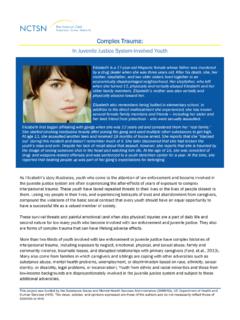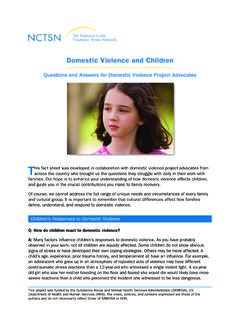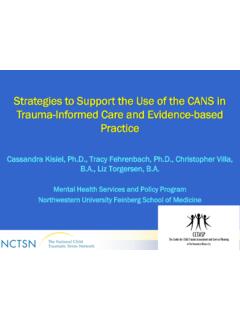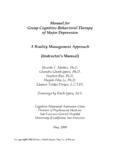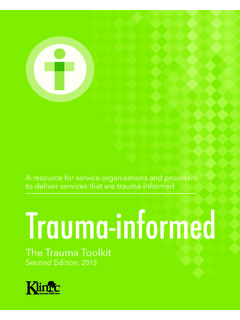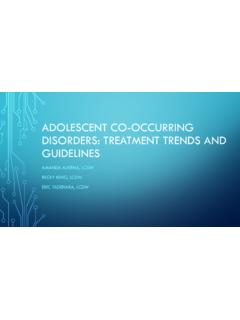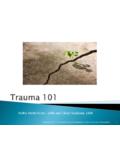Transcription of NCTSN Fact Sheet Template - The HHYP
1 This project was funded by the Substance Abuse and Mental Health Services Administration (SAMHSA), US Department of Health and Human Services (HHS). The views, policies, and opinions expressed are those of the authors and do not necessarily reflect those of SAMHSA or HHS. Complex Trauma: Facts For Service Providers Working with Homeless Youth and Young Adults Homeless street youth have become part of the landscape in most large American cities. Though the prevalence of youth homelessness is difficult to measure, researchers estimate that between 1 million to million youth per year experience homelessness1. Though their backgrounds are diverse, research suggests that most of these youth have experienced early and multiple traumas. As a result, many home-less youth have a history of complex trauma causing significant mental health problems, including depres-sion, anxiety disorders, PTSD, suicidal ideation, attachment issues, and substance abuse disorders.
2 Young people s responses to trauma are shaped at least in part by their age, gender, ethnicity, and sexual orientation. While most of these traumatic events occur before they leave home, many youth are re-traumatized once they arrive on the street. Thus, these youth struggle to recover from traumatic events at the same time that they are trying to survive in a hostile street environment. Charles is a homeless 18-year-old with a long history of physical abuse and neglect. He was placed in a number of foster homes, then ran away to live on the street. He has used a variety of resources in the community since he became homeless about two years ago, and many agencies know him. When trying to access services, Charles often has run-ins with staff. He loses his temper easily and often, when staff try to redirect him or try to enforce program rules, will leave appointments abruptly.
3 Charles longest stay in a residential program has been three weeks due to his difficulties relating to others and complying with rules. Charles appears to have friends, but his frequent verbal and sometimes physical arguments result in relationships that are short-lived. While quite articulate and bright, Charles dropped out of school after completing the ninth grade. When case managers set him up with tasks or schedules to help him pursue his GED or high school diploma, Charles struggled to make appointments and follow his case plan. Additionally, Charles has not found a job despite his apparent desire to work. He reports occasional drug and alcohol use, especially when feeling depressed or anxious. 2 Complex Trauma: Facts for Service Providers Working with Homeless Youth and Young Adults March 2014 HOW DOES COMPLEX TRAUMA AFFECT HOMELESS YOUTH?
4 Interaction with staff members and authority figures. Many homeless youth have a history of involvement with the child welfare and/or justice systems. Being abused or neglected, separated from family members, placed in the homes of strangers, or incarcerated may lead some youth to distrust authority figures and make them reluctant to disclose personal information. As safety and trust issues are paramount for homeless youth, they are likely to test staff to determine if they are reliable, honest, and consistent, and it may take some time for staff to gain the trust and respect of these young people. Program staff can acknowledge past experiences of loss and betrayal, let youth know that they have the right to share only the information that they want to share, and give youth the time and space they need to develop a trusting relationship with staff.
5 Interaction with their peers. Many homeless youth have had chronic or repeated abuse or neglect by a parent or caregiver and, therefore, may have difficulty relating to others, including their peers. They may not be able to connect at all, avoiding contact with others, or they may over-attach to peers and become preoccupied with others. For instance, a young man may have a best friend one day and be verbally aggressive and hateful toward him the next day. Many homeless youth create street families in an attempt to find the unconditional love and support that they did not receive from their parents/caregivers. These alliances, particularly with older, more seasoned street youth, may initially keep them safe but may contribute to further victimization and prevent them from accessing services.
6 Homeless youth may tolerate abusive behavior from their street family or exploitive adults in exchange for a semblance of protection. Program staff can help create opportunities for youth to interact appropriately with their peers and model positive communication. Staff must provide alternative ways for youth to seek safety while facilitating their expression of feelings. Ability to participate in programs and follow through on case plans. Many front line staff become frustrated with youth who seem unable or unwilling to comply with the rules and meet the expectations of the service agency. Complex trauma may cause youth difficulty in regulating emotions, relating to others, planning for the future, and following through with beneficial activities. Depression, learned helplessness, learning challenges, and fear of failure can compound these difficulties.
7 Program staff should keep in mind the impact of trauma on adolescent development, identify appropriate expectations for these youth, and patiently support youth in achieving age-appropriate skills. Positive experiences and trusting relationships can help youth recover from the effects of trauma. WHAT IS COMPLEX TRAUMA? The term complex trauma describes both children s exposure to multiple traumatic events often of an invasive, interpersonal nature and the wide-ranging, long-term impact of this exposure. These events are severe and pervasive, such as abuse or profound neglect. They usually begin early in life and can disrupt many aspects of the child s development and the formation of a self. Since they frequently occur in the context of the child s relationship with a caregiver, these events interfere with the child s ability to form a secure attachment bond.
8 Many aspects of a child s healthy physical and mental development rely on this primary source of safety and stability. Many children with complex trauma histories suffer a variety of traumatic events, such as physical and sexual abuse, witnessing domestic and community violence, separation from family members, and re-victimization by others. Complex trauma can have severe effects on an individual s global functioning. Complex trauma can have devastating effects on a child s physiology; emotions; ability to think, learn, and concentrate; impulse control; self-image; and relationships with others. Across the life span, complex trauma is linked to a wide range of problems, including addiction, chronic physical conditions, depression and anxiety, self-harming behaviors, and other psychiatric disorders.
9 The national child traumatic stress network 3 RECOMMENDATIONS Homeless youth are highly impacted by complex trauma. traumatic experiences at home, in the community, and on the street affect their ability to trust others, make healthy connections with their peers, and be successful in programs designed to help them achieve stability. Staff who serve homeless youth can help them form positive attachments, accept support from adults and peers, recover from past trauma, and master the skills needed to function in a healthier manner. The following are examples of how staff can assist youth in transitioning from street life to a pro-social and stable way of life. Intake and Assessment Establish safety and trust. Encourage youth as they are ready to share information and their personal history.
10 Youth need to know that no services will be withheld if they don t answer specific questions. Assess the need and readiness for therapeutic interventions, and make appropriate referrals. Prioritize youth s immediate needs, such as safety, food, shelter, and clothing. Remember that the chronological age of the youth may not match his or her present intellectual, emotional, or maturity levels. Acknowledge past experiences of loss and betrayal. Consider a young person s behavior in the context of his or her life experiences; behaviors may appear appropriate in light of traumatic experiences. On-Going Care Create opportunities for youth to appropriately connect and interact with their peers. Create opportunities for youth to develop skills in the areas of understanding and monitoring their emotions, decision-making, self-care, and problem-solving.


